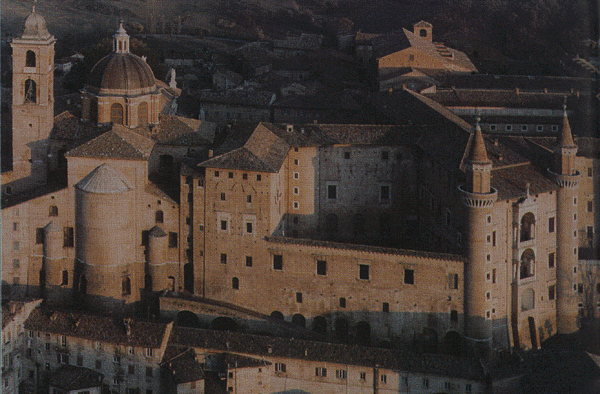
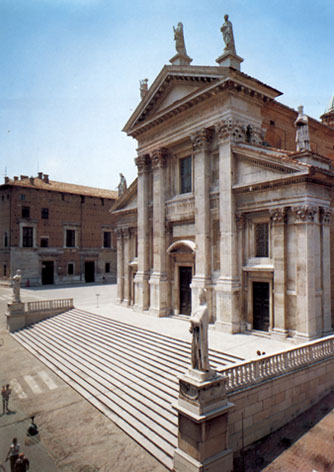
|
Urbino is situated on two plateaux overlooking the Metauro and Foglia valleys. It is one of Italy's most important and fascinating towns from an historical, artistic and cultural viewpoint. It was the cradle of a splendid Renaissance court which had its centre in the Ducal Palace of the ruling Montefeltro family and on which converged painters and writers from the entire Country. Urbino has remained a prestigious cultural centre, home of a notable University (drawing most of its students from all over Italy and abroad), many Academies of art, study centres and institutions.
The central square of Urbino is the Piazza Duca
Federico, it is here that the Ducal Palace stands.
To the South is the adjacent Piazza Risorgimento,
one side of which is flanked by a large part of the oldest wing of the Palace.
Almost at the point of convergence of these two Piazzas stands the Egyptian
Obelisk, a piramidal column formed of superimposed blocks and carved with
hieroglyphs. Facing the Obelisk is the Church of San Domenico, while flanking
the Palazzo Ducale is the Cathedral (or Duomo). |
 |
 |
The outer appearance of this imposing building suggest the care with which
it was planned and built. The facade is structured between twin towers -"I Torricini"- with
successive layers of balconies one above the other.
Past the great doorway in travertine marble is the Cortile d'Onore, with a portico
extending along its entire perimeter, notable for the chromatic effect given by the mix of brick and stone.
From the ground floor it is possible to enter into the basement of the palace composed of specialized rooms
necessary for the functioning of life at the Court. These rooms
have only quite recently been opened to the public and their layout and appurtenances document the
aspects of daily life during the Renaissance.
Located on this floor, near the Courtyard, there is the Duke's Library, once described by
Baldassarre Castiglione as the "supreme excellence of the great Palace". In it were
gathered the numerous codices of Federico da Montefeltro, a collection of extraordinary
importance thanks also to his familiarity with classical culture. The rooms adjoining
the library contain several works by Ambrogio Barocci: reliefs representing ships,
machines and instruments of both artistic and documentary value on renaissance technology.
Still on the ground floor, between the Cortile d'Onore
and Piazza Rinascimento, it is possible to visit the Archeological Museum.
On the first floor the first rooms to be entered are those which represents the ancient heart of
the building. From here, the visitor enters the "new court", going through
the guest rooms to arrive at the apartments of the Duke where it is possible to view
some of the most beautiful pieces on show in what is now the National Gallery of the Marches.
|
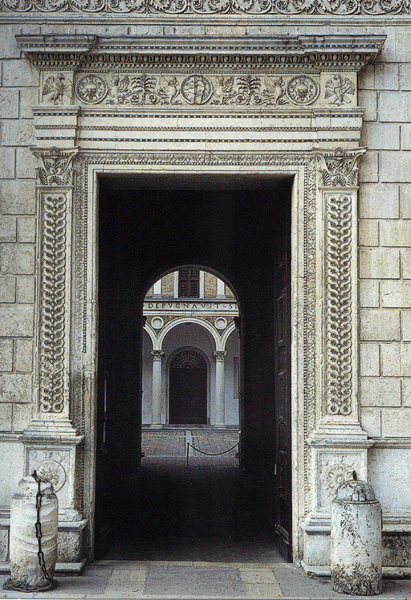 Main entrance to the Ducal Palaceçade |
The Sala delle Udienze (Audience Chamber) contains two splendid masterpieces by Piero della Francesca
(1415/20-1492), the Madonna of Senigallia- a title which indicates the town where
the picture was kept until 1917- and the Flagellation. This latter pieces represents one of the most
important and enigmatic works by the artist from Sansepolcro.
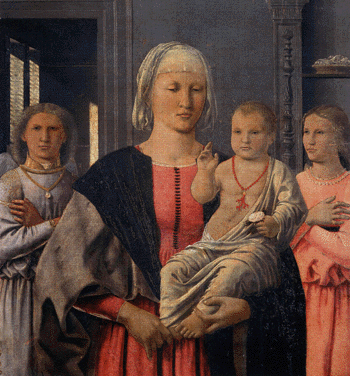 Madonna of Senigallia |
These two rooms seem to exhalt on equal levels Christian divinity and the figures of Classical mythology.
The first contains a vault decorated with cherubs, while the second was once home to Apollo and the Muses,
eight small works by Giovanni Santi, father of Raphael, and Timoteo Viti.
The final room in the Ducal Apartment is the Sala degli Angeli, so called because of
the friezes by Domenico Rosselli (1439-1498), which decorate the fireplace in the centre of the room which
contains two paintings that are extremely famous the world over: the Ideal City and the Profanation of the
Host. In this last painting Paolo Uccello, in a startingly modern style, narrates the miracle that supposedly occurred
in Paris in 1290. There is no such certainty, however, with regard to the painter of the Ideal City.
The many misteries surrounding this city with its ingenious perspective have made the
painting even more fascinating, consecrating its role as emblem of the Italian Renaissance.
 |
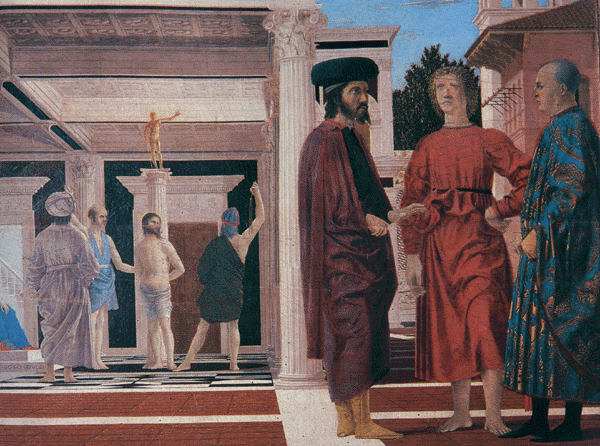 Piero della Francesca's Flagellation is one of the most important works of art displayed in the Palace, and is among the most important produced by the Tuscan artist from Borgo San Sepolcro (1415/1420-1492). |
On the same floor there is also the enormous Salone D'Onore, also known as the "Throne Room", because the Papal throne was kept here during the period of the Church Rule (1631-1861). This is followed by the Sala delle Veglie (Gathering Hall) which bears the hallmark of Francesco di Giorgio Martini and leads through to the rooms which form the Duchess' apartments. Here is possible to see such precious works of art as Raphael's Portrait of a Gentlewoman, also known as La Muta, alonside Saint Catherine of Alexandria, painted by the same artist in his youth. The Duchess' bed Chamber, dressing room and the Stanza delle Preghiere, end the visit to the first floor. The second floor of the Ducal Palace brings the visitors to another area, marking the passing from the Montefeltro family to that of Della Rovere. In this last part of the National Gallery of the Marches is housed a vast collection of minor works of art.